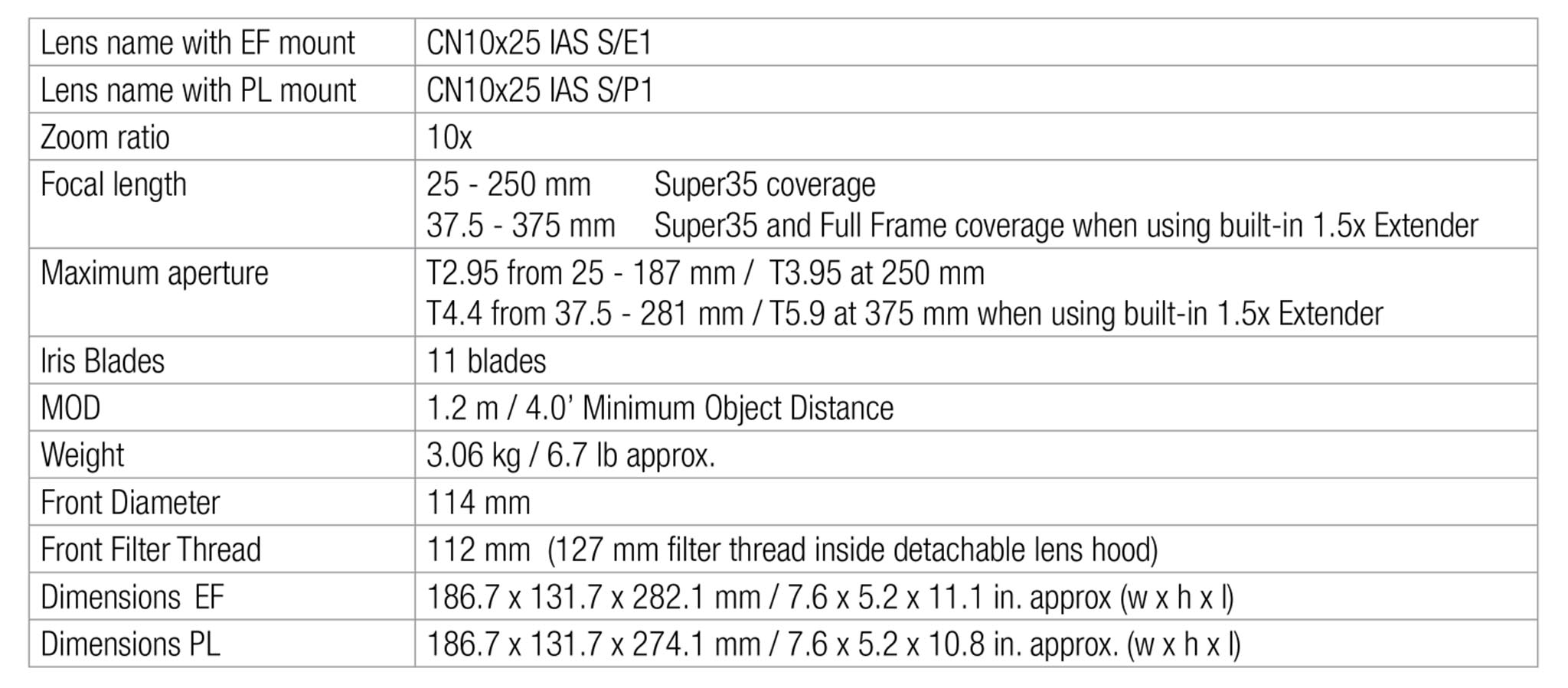Canon’s new CINE-SERVO 25-250 mm T2.95-3.95 is an opto-mechanical marvel. It weighs a mere 6.7 lb and is about 11 inches long. It comes in PL or EF mount.
In M.O.D. Mode, shooting at the tight end with its built-in 1.5x Extender, this CINE-SERVO can fill the frame with an average credit card.
Usually you don’t handhold a 10:1 zoom. This one you can. And, with the internal 1.5x range extender, you can increase your selection of focal lengths from 25 to 375 mm.
To borrow a famous film title, this Extremely Light and Incredibly Close lens covers a wide range of cameras and formats, not only on Super35 cameras like the new Canon EOS C300 Mark III, but also Full Frame.
With the built-in 1.5x Extender engaged, it becomes a 37.5-375 mm T4.4-5.9 zoom lens with image coverage up to around 44.42mm Ø (as estimated by FDTimes—see explanation on page 35.) And so, you can use this CINE-SERVO Zoom in Full Frame/VV/Large Format/Ultra35 for most aspect ratios on ALEXA LF, Mini LF, Mini, Sony VENICE, RED MONSTRO 8K VV.
Canon CINE-SERVO 25-250 mm T2.95-3.95
The new CINE-SERVO 25-250 mm T2.95-3.95 Zoom joins a Canon family of remarkable Super35 format CINE-SERVO Zooms. The wide CINE-SERVO 17-120 mm is a documentary darling. The CINE-SERVO 50-1000 mm (75-1500 mm with built-in 1.5x extender) is amazingly small and light for something with such a long range.
The last time a 25-250 came close in weight and size was in 1962. The Angenieux 10x25B f/3.2 T3.7 zoom was 9.5 lb (4.3 kg).
These days, most 10:1 zooms come in at 10 to 18 lb.
To keep size and weight down, the Canon CINE-SERVO 25-250 mm has a slight ramping of the aperture at the long end when wide open.
PL Mount is compatible with Cooke /i Technology lens metadata protocol.
EF Mount is compatible with Canon EF lens mount communication protocol.
EF Mount and PL Mount can be swapped at an authorized Canon service facility.
Canon CINE-SERVO 25-250 mm T2.95-3.95
Witness marks and scales are engraved on both sides of the lens.
Focus distance is indicated in both Imperial and Metric scales. You do not have to change lens rings.
Distance in Feet is marked in white. Distance in Meters is marked with green luminous paint that is visible in the dark.
Canon CINE-SERVO 25-250mm T2.95-3.95 Specs
Minimum Object Distance and Minimum Object Size at 1.2m / 4.0′
Magnificaton Ratio = Minimum Object Size ÷ Sensor Size
Canon CINE-SERVO 25-250mm T2.95-3.95 Image Coverage
Although Canon does not publish lens image circles, FDTimes calculates that the Image Circle coverage of the CINE-SERVO 25-250mm T2.95-3.95 is approximately:
29.61 mm Ø for Super35
and
44.42 mm Ø for Full Frame / VV/ Large Format / Ultra35
with the 1.5x Extender engaged
How did we arrive at these numbers? This sounds like an SAT question.
Answer: Well, we could look at the Canon EOS C300 Mark III’s Super35 sensor specs on page 26 or 29. Image area is 26.2 x 13.8 mm.
Or do the math:
Or go online to Google’s Pythagorean Theorem Calculator. Enter 26.2 mm for one leg of the triangle. Enter 13.8 mm for the other leg. The hypotenuse (image diagonal) is calculated: 29.61 mm.
Therefore, because we have been told that the Canon CINE-SERVO 25-250mm T2.95-3.95 covers the full sensor of the EOS 300 Mark III, I think we can agree that the image circle diameter of the lens is at least as large as the sensor’s.
To arrive at the image coverage for Full Frame / VV/ Large Format / Ultra35 and formats larger than Super35, let’s calculate as follows.
Multiply the Super35 image diagonal of 29.61 mm by 1.5 (which is the ratio of the built-in 1.5x Extender) and we get 44.42 mm Ø.
Note, these are FDTimes numbers, not Canon’s. Your “mileage” may vary. Image Circle Diagonal is an imprecise number. It is often mixed up with Image Illumination. You might love the focus fall off and shading around the edges of frame that would have the lens designers shaking their heads. Therefore, the best way to judge Image Circle is to look at the lens on a projector, shoot a test, and see the results.
Thanks to the Canon Optics Team for helping with the math and guiding the way.
Canon CINE-SERVO 25-250mm T2.95-3.95 Aperture Ramping Explained
There are common misconceptions about aperture ramping. Here are some things to remember:
1. Aperture ramping typically occurs wide open, when the iris is set to T2.95.
2. The aperture ramping is gradual.
3. As you stop the iris down from wide open, the T-Stop drop-off point shifts toward the telephoto end. If you stop the iris down past T3.95, then aperture ramping no longer occurs.
4. The same concept holds true when using the 1.5x Extender. Note that with the 1.5x Extender engaged, you will have to calculate the light loss (and resulting T-Stop) yourself.
This article first appeared in FDTimes April 2020 Issue 101.




















